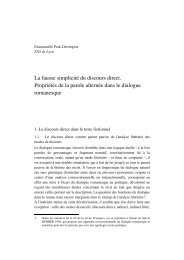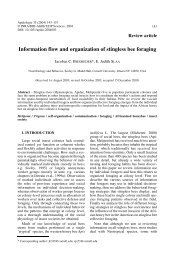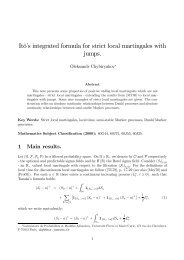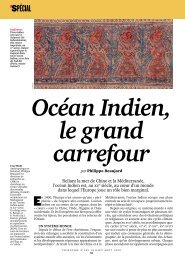Simplified apparatus for instrumental insemination of queen bees ...
Simplified apparatus for instrumental insemination of queen bees ...
Simplified apparatus for instrumental insemination of queen bees ...
Erfolgreiche ePaper selbst erstellen
Machen Sie aus Ihren PDF Publikationen ein blätterbares Flipbook mit unserer einzigartigen Google optimierten e-Paper Software.
Original article<br />
<strong>Simplified</strong> <strong>apparatus</strong> <strong>for</strong> <strong>instrumental</strong><br />
<strong>insemination</strong> <strong>of</strong> <strong>queen</strong> <strong>bees</strong><br />
with the ’flexible <strong>insemination</strong> technique’<br />
ME Kühnert<br />
HH Laidlaw<br />
1<br />
Institut für Bienenkunde (Polytechnische Gesellschaft), Fachbereich Biologie der<br />
JW Goethe-Universität Frankfurt am Main, Karl-von-Frisch-Weg 2, 61440 Oberursel, Germany;<br />
2<br />
University <strong>of</strong> Cali<strong>for</strong>nia, Department <strong>of</strong> Entomology, Davis, CA 95616-8584, USA<br />
Summary — With the usual <strong>insemination</strong> method the sting chamber is kept open by two hooks and the<br />
sting retracted with the dorsal hook (sting hook). With the new <strong>apparatus</strong>, and the ’flexible’ <strong>insemination</strong><br />
technique, hook supports are no longer required. The sting is simply grasped by a pair <strong>of</strong> <strong>for</strong>ceps<br />
and pulled up to create a large opening into which the <strong>insemination</strong> syringe can be easily inserted. The<br />
sternite is kept in place by a small hook attached to the <strong>queen</strong> holding tube. In 10 pairs <strong>of</strong> <strong>queen</strong>s<br />
inseminated with either the classical (A) or the new (B) method, no differences were found in the num-<br />
semen had 2.7 + 0.3<br />
ber <strong>of</strong> spermatozoa that reached the spermatheca. Queens inseminated with 5 μl<br />
million (A; n 6), and 2.8 = + 0.9 million (B; n 6) spermatozoa in the spermatheca. With 10 μl<br />
= semen<br />
the average was 4.7 + 1.0 million (A; n 4), and 4.9 = + 1.4 million (B; n 4) spermatozoa in the = spermatheca.<br />
Size and costs <strong>of</strong> the equipment are significantly reduced and the <strong>insemination</strong> routine<br />
becomes faster.<br />
Apis mellifera / reproduction / <strong>instrumental</strong> <strong>insemination</strong> / equipment<br />
INTRODUCTION<br />
the<br />
Instrumental <strong>insemination</strong> <strong>of</strong> <strong>queen</strong> <strong>bees</strong> is<br />
accomplished with a complex <strong>apparatus</strong><br />
that keeps the <strong>queen</strong> narcotized and held<br />
in position (Laidlaw, 1949; Ruttner et al,<br />
1974; Laidlaw and Lorenzen, 1977; Laidlaw<br />
and Goss, 1990; Woyke, 1991). Usually<br />
the sting chamber is kept open by two<br />
hooks (Nolan 1932, 1937a, b), one ventral<br />
hook and one dorsal or sting hook (Laidlaw,<br />
1944). With the aid <strong>of</strong> a probe, or with<br />
syringe tip itself, the valvefold is lifted<br />
to allow the syringe to enter the <strong>queen</strong>’s<br />
median oviduct (Laidlaw, 1944, 1977; Mackensen,<br />
and Roberts, 1948; Ruttner, 1975;<br />
Schley, 1983; Harbo, 1985; Moritz, 1989).<br />
Correct placement <strong>of</strong> the hooks is essential<br />
and alignment <strong>of</strong> the syringe a matter<br />
<strong>of</strong> experience.<br />
After more knowledge about anatomical<br />
details during the mating flight became available<br />
(Koeniger, 1984) new dorsal hooks<br />
have been designed (Schafferhans, 1987;
Schley 1988) and the ’flexible <strong>insemination</strong><br />
technique’ without dorsal hook was developed<br />
(Kühnert, 1989, 1991). The <strong>insemination</strong><br />
procedure has thus become less<br />
complicated, however, equipment has<br />
become sophisticated and expensive in the<br />
’classical’ <strong>insemination</strong> method. Our objective<br />
was to simplify the <strong>apparatus</strong> so the<br />
average bee breeder will be able to af<strong>for</strong>d<br />
the equipment. A new <strong>insemination</strong> <strong>apparatus</strong><br />
has been designed which is both simple<br />
and inexpensive.<br />
MATERIALS AND METHODS<br />
Insemination equipment<br />
General description (fig 1A)<br />
The base <strong>of</strong> the <strong>apparatus</strong> is a metal block in<br />
which the CO 2 supply tube connects the Laidlaw-<br />
Goss <strong>queen</strong> holder. A new type <strong>of</strong> ventral hook is<br />
fastened to one side <strong>of</strong> the <strong>queen</strong> holder tube<br />
like a pencil holding clip. It can be adjusted up<br />
and down as needed. The dorsal hook (sting<br />
hook) is eliminated and a hand-held pair <strong>of</strong> <strong>for</strong>ceps<br />
is used (Kühnert, 1989, 1991). The type <strong>of</strong><br />
syringe and syringe holder can be <strong>of</strong> various<br />
designs. We used a rack and pinion syringe slide<br />
after Ruttner et al (1974) and a Schley (1982)<br />
syringe. A 180-220 mm syringe post is recommended,<br />
fixed to a base plate <strong>of</strong> any convenient<br />
size to fit over or under the binocular base. The<br />
stand can also be separate.<br />
The base with the <strong>queen</strong> holder can be easily<br />
moved out <strong>of</strong> the way when space is needed <strong>for</strong><br />
semen collection. For easy repositioning, two<br />
marks on the microscope stage and matching<br />
ones on the <strong>queen</strong> holder base are useful. Any<br />
convenient orientation to the microscope may be<br />
used. Leaning the base against two microscope<br />
clamps (fig 2C) or against suction cups prevents<br />
sliding. If a base plate that carries the syringe<br />
holder post is used above the microscope stage,<br />
a position guide can be made <strong>of</strong> a right angle<br />
brass fixed to the plate. The two arms fit against<br />
the edge <strong>of</strong> the properly placed <strong>queen</strong>-holding<br />
base.<br />
Construction details <strong>of</strong> the <strong>apparatus</strong><br />
(fig1B)<br />
The base <strong>for</strong> the <strong>queen</strong> holder is a 20-mm thick<br />
disk cut from a brass rod 60 mm in diameter (1).<br />
The bottom side <strong>of</strong> the disk is recessed 2 mm to<br />
avoid ’rocking’ on a surface (2). A blind hole,<br />
6 mm in diameter (optionally threaded) is drilled<br />
from the top, 18 mm from one side at the preferred<br />
angle (25° to 32° from perpendicular) (3).<br />
Another hole is drilled from the side into the slanting<br />
blind hole to receive a brass tube ’fitting’ <strong>for</strong><br />
attachment <strong>of</strong> Latex tubing <strong>for</strong> conduction <strong>of</strong> CO2<br />
(4). The stopper, a tube that fits into the 6-mm<br />
slanted hole (5), holds the <strong>queen</strong> holding tube<br />
(8) and allows CO2 access. It is made according<br />
to Laidlaw and Goss (1990) with a CO2 outlet at<br />
the flattened end (6) and a rubber O-ring (7) <strong>for</strong><br />
the <strong>queen</strong> holding tube to sit on and prevent CO2<br />
leakage. A piece <strong>of</strong> 10 X 33 mm sheet metal<br />
(brass) (9) is shaped to gird the <strong>queen</strong> holding<br />
tube just tight enough to be easily moved up and<br />
down. This clasp carries the ventral hook (10)<br />
which is made <strong>of</strong> a piece <strong>of</strong> 0.2 mm stainless<br />
steel wire welded or glued to the outside <strong>of</strong> the<br />
clasp. The wire is shortened to exceed the metal<br />
by 15 to 18 mm and is hammered flat at the protruding<br />
end. Cutting edges are ground. The wire<br />
is bent to <strong>for</strong>m a hook that grips the sternite <strong>of</strong><br />
the <strong>queen</strong>.<br />
Insemination procedure<br />
To introduce the <strong>queen</strong> into the holding tube the<br />
CO2 gas is turned on and the clasp with the ventral<br />
hook is slid towards the upper end <strong>of</strong> the<br />
<strong>queen</strong> holding tube (fig 2A). The <strong>queen</strong>’s head<br />
is introduced into the tube and upon crawling into<br />
the tube, she is immediately narcotized. As<br />
<strong>queen</strong>s tend to bend ventrally it is easier to have<br />
the <strong>queen</strong>’s dorsal side facing left (towards the<br />
ventral hook). In this case the holding tube with<br />
the narcotized <strong>queen</strong> is then rotated 180° (while<br />
the clasp is kept in place) to have the <strong>queen</strong> in<br />
correct position <strong>for</strong> <strong>insemination</strong> (ventral side to<br />
the left, dorsal to the right). Queens can also be<br />
narcotized in their cages be<strong>for</strong>e introduction into<br />
the <strong>queen</strong> holder. The semen syringe is aligned<br />
with the <strong>queen</strong> holding tube and the clasp is lowered<br />
until the ventral hook catches the sternum <strong>of</strong><br />
a needle or hook<br />
the <strong>queen</strong> (fig 2B). If necessary<br />
can be used to open the <strong>queen</strong>’s sting chamber.
With pointed <strong>for</strong>ceps the sting is gripped and lifted<br />
in the dorsal direction (fig 2C,D). To get hold <strong>of</strong> the<br />
sting with a steady left hand it is important to support<br />
the elbow and the hand, regardless <strong>of</strong><br />
whether the sting is grasped from the rear <strong>of</strong> the<br />
<strong>apparatus</strong> (fig 2C) or from the front. While lifting<br />
the sting with <strong>for</strong>ceps the sting chamber is<br />
stretched and opens <strong>for</strong>ming a funnel. Minor corrections<br />
<strong>of</strong> the <strong>queen</strong>’s position are possible by<br />
careful sting movements until the vaginal orifice<br />
becomes clearly visible and the tip <strong>of</strong> the <strong>insemination</strong><br />
syringe can be inserted guided by the two<br />
basal arms <strong>of</strong> the sting. After semen is inserted<br />
the <strong>queen</strong> holding tube is removed from the stopper<br />
and the <strong>queen</strong> is shaken or blown head first<br />
out <strong>of</strong> the tube.<br />
Comparison <strong>of</strong> efficacy <strong>of</strong> the novel<br />
and the traditional <strong>apparatus</strong><br />
The efficacy <strong>of</strong> the above <strong>insemination</strong> <strong>apparatus</strong><br />
and method (B) was compared to the classical<br />
<strong>insemination</strong> <strong>apparatus</strong> and method (A) using<br />
the conventional ventral hook, dorsal hook and<br />
valvefold probe. Glass tips were used in both<br />
cases.<br />
Twenty <strong>queen</strong>s were inseminated with 5 μl or<br />
10 μl semen from consecutive portions <strong>of</strong> stirred<br />
semen in a syringe by random choice <strong>of</strong> the<br />
<strong>insemination</strong> <strong>apparatus</strong>. They received a 5-min<br />
CO2 treatment 24 h prior to <strong>insemination</strong>. The<br />
<strong>queen</strong>s were kept in mating nucs with about 1500<br />
workers. Four or six weeks after <strong>insemination</strong> the<br />
number <strong>of</strong> spermatozoa in the spermatheca was<br />
counted in 10 pairs <strong>of</strong> <strong>queen</strong>s with a Fuchs-<br />
Rosenthal haemacytometer.<br />
RESULTS AND DISCUSSION<br />
There was no difference (table I) in the number<br />
<strong>of</strong> spermatozoa found in the spermatheca<br />
<strong>of</strong> <strong>queen</strong>s inseminated by the two<br />
methods (t = 0.36, ns, DF=9). All <strong>queen</strong><br />
<strong>bees</strong> had normal reproductive organs and<br />
did not show any sign <strong>of</strong> damage. With the<br />
new <strong>apparatus</strong> the number <strong>of</strong> spermatozoa<br />
found in the spermatheca is within the range<br />
found by Mackensen (1964) and Woyke<br />
(1971).<br />
One <strong>of</strong> the major advantages <strong>of</strong> the new<br />
device is that it can be manufactured at low<br />
costs with standard parts. Using the new<br />
’clip-on’ hook and a pair <strong>of</strong> <strong>for</strong>ceps, the conventional<br />
pairs <strong>of</strong> expensive hooks, stands<br />
and hook holders are no longer necessary.<br />
Additionally, mobility <strong>of</strong> the <strong>queen</strong> block<br />
allows plenty <strong>of</strong> space during semen collection<br />
and <strong>queen</strong> manipulation. Repositioning<br />
is easily accomplished with matching<br />
marks around the block and on the microscope<br />
stage or syringe stand. Also the<br />
<strong>queen</strong>’s position can be corrected precisely<br />
by fractional horizontal movements <strong>of</strong> the<br />
small block. Thus it is possible to use a simple<br />
type <strong>of</strong> syringe holder. If a fixed position<br />
is preferred the <strong>queen</strong> block can be<br />
connected to the syringe stand.<br />
One problem with the classical <strong>insemination</strong><br />
<strong>apparatus</strong> is that the working distance<br />
is too small to be used with many<br />
common microscopes. Low height and small<br />
size <strong>of</strong> the new <strong>insemination</strong> <strong>apparatus</strong> plus<br />
the ability to move the syringe stand further<br />
away from the <strong>queen</strong> holder permit more<br />
types <strong>of</strong> microscopes to be used without<br />
alterations. To utilize lower working distances,<br />
four holes <strong>for</strong> the stopper were<br />
drilled into the base plate at angles <strong>of</strong> 25°,<br />
27°, 29° and 32°. We preferred to work at<br />
the 25° angle, but even with working distances<br />
lower than that implied by the 32°<br />
angle, there is no hook to hinder insertion <strong>of</strong><br />
the syringe. The new device allows the use<br />
<strong>of</strong> various syringe designs, including those<br />
with very long capillary tubes.<br />
Narcotizing the <strong>queen</strong>s be<strong>for</strong>e placing<br />
them into the <strong>queen</strong> holder eases the introduction<br />
procedure and makes sure that the<br />
duration <strong>of</strong> CO2 treatment is sufficient to<br />
start onset <strong>of</strong> oviposition.<br />
After 5 years experience in using <strong>for</strong>ceps<br />
instead <strong>of</strong> a dorsal hook, we have found<br />
that the <strong>insemination</strong> procedure can be<br />
accomplished with the same success rate in<br />
about 20% less time. By lifting the sting with<br />
<strong>for</strong>ceps the vaginal opening becomes visible
which makes insertion <strong>of</strong> the syringe much<br />
easier. Sometimes the vaginal orifice opens<br />
wide enough to see the valvefold being laid<br />
down or erected by pulling the sting.<br />
It is intended that this new <strong>apparatus</strong> will<br />
make <strong>instrumental</strong> <strong>insemination</strong> more widely<br />
available to bee breeders. In teaching<br />
classes at the University <strong>of</strong> Western Sydney<br />
(Hawkesbury), Australia and at bee<br />
research institutes in Kirchhain, and in<br />
Oberursel, Germany the ’flexible <strong>insemination</strong><br />
technique’ was rapidly learned by beekeepers.<br />
Since only 10-fold magnification<br />
is necessary, it may be possible to replace<br />
the binocular microscope in the future with<br />
a simpler and economical magnifying<br />
device. Practical use will show whether the<br />
described <strong>apparatus</strong> will be accepted and<br />
helps to make <strong>instrumental</strong> <strong>insemination</strong><br />
more commonly used in bee breeding.<br />
ACKNOWLEDGMENTS<br />
We dedicate this work to Pr<strong>of</strong> F Ruttner at his<br />
80th birthday, who is a pioneer <strong>of</strong> <strong>instrumental</strong><br />
<strong>insemination</strong> <strong>of</strong> <strong>queen</strong> <strong>bees</strong>.<br />
We are grateful to N Koeniger and S Fuchs<br />
<strong>for</strong> support and comments on the manuscript.<br />
We thank P Walzer <strong>for</strong> manufacturing the <strong>apparatus</strong>,<br />
Ch Rau <strong>for</strong> the photographs, and A Mohr <strong>for</strong><br />
the drawing.<br />
Deutsche Version<br />
Vereinfachter Apparat zur instrumentellen<br />
Besamung von Bienenköniginnen mit<br />
der ’Flexiblen Besamungsmethode’<br />
Zusammenfassung — Bei der herkömmlichen Besamungsmethode halten zwei Häkchen die Stachelkammer<br />
geöffnet, wobei der dorsale Haken den Stachelapparat zurückhält, die darunterliegende<br />
Vaginalöffnung jedoch nicht sichtbar wird. Mit dem neuen Apparat und der "Flexiblen Besamungsmethode"<br />
werden Häkchenhalterungen überflüssig. Der Ventralhaken ist verschiebbar auf das gerade<br />
Königinnenröhrchen aufgesteckt. Mit einer Pinzette wird der Königinnenstachel angehoben und nach<br />
dorsal bewegt, bis die Vaginalöffnung deutlich sichtbar ist und die Besamungsspritze eingeführt werden<br />
kann. In einem Vergleich zwischen Besamungen mit herkömmlicher Methode und -Gerät (A) und<br />
dem neuen Gerät (B) wurde kein Unterschied in der Anzahl der Spermien, die die Spermatheka erreichen,<br />
festgestellt. Königinnen, die mit 5 μl Sperma besamt waren, hatten 2.7 ± 0.3 Millionen Spermien<br />
(n = 6) (A), und 2.8 ± 0.9 Millionen Spermien (n = 6) (B) in der Spermatheka. Mit 10 μl Besamungsmenge<br />
lag der Durchschnitt bei 4.7 ± 1.0 Millionen (n = 4) (A) und 4.9 ± 1.4 Millionen (n = 4) (B) Spermien in<br />
der Spermatheka. Das Gerät ist leicht und preiswert herzustellen. Die Methode ist schnell zu erlernen<br />
und die Besamung damit ist einfach und zeitsparend.<br />
Apis mellifera / Reproduktion / instrumentelle Besamung / Besamungsapparate
EINLEITUNG<br />
Instrumentelle Besamung von Bienenköniginnen<br />
wird mit Hilfe von komplizierten<br />
Apparaten durchgeführt, in welchen die<br />
Königin narkotisiert und in der Besamungsposition<br />
festgehalten wird (Laidlaw, 1949;<br />
Ruttner et al, 1974; Laidlaw und Lorenzen,<br />
1977). Meist wird die Stachelkammer mit<br />
zwei Haken <strong>of</strong>fen gehalten (Nolan, 1932,<br />
1937a, b), einem Ventralhaken und einem<br />
Dorsal- oder Stachelhaken (Laidlaw, 1944).<br />
Unter Zuhilfenahme einer Sonde oder mit<br />
der Besamungsspritze selbst muß die<br />
Scheidenklappe (Valvula vaginalis) angehoben<br />
werden, um die Besamungsspritze<br />
in den mittleren Eileiter einführen zu können<br />
(Laidlaw, 1944, 1977; Mackensen und<br />
Roberts, 1948; Ruttner, 1975; Schley, 1983;<br />
Harbo, 1985; Moritz, 1989). Korrektes Einsetzen<br />
und Form des Dorsalhakens waren<br />
ebenso ausschlaggebend für den Erfolg wie<br />
das Ausrichten der Spritze auf die meist<br />
verdeckte Vaginalöffnung.<br />
Nachdem Arbeiten von Koeniger (1984)<br />
Aufschluß über die anatomischen Verhältnisse<br />
beim Paarungsflug gaben, folgten Veränderungen<br />
der Dorsalhaken (Schafferhans,<br />
1987; Schley, 1988) sowie die Entwicklung<br />
der ’Flexiblen Besamungsmethode’ ohne<br />
Dorsalhaken (Kühnert, 1989, 1991). Trotz<br />
Neuerungen bei den Besamungsapparaten<br />
(Laidlaw und Goss, 1990; Woyke, 1991) blieben<br />
diese doch kompliziert und teuer. Unser<br />
Anliegen war es, das Gerät so zu vereinfachen,<br />
daß jeder interessierte Imker es kaufen<br />
(oder bauen) und handhaben kann.<br />
MATERIAL UND METHODE<br />
Besamungsinstrument<br />
Allgemeine Beschreibung (Abb 1 A)<br />
Das Gerät besteht aus einer Metallscheibe, in<br />
welcher die CO2-Zuleitung auf den Laidlaw-Goss<br />
Königinnenhalter trifft. Ein neuartiger Ventralhaken<br />
ist an einer ’Spange’befestigt, die um das<br />
Königinnenröhrchen greift (ähnlich der Halteklemme<br />
an einem Schreibstift). Der Haken kann<br />
mit der Spange auf und ab bewegt werden. Der<br />
Dorsalhaken (Stachelhaken) wird durch eine<br />
handgeführte Pinzette ersetzt (Kühnert 1989,<br />
1991). Unterschiedlicher Königinnengröße kann<br />
durch Verschieben des O-Ringes am Stopper<br />
Rechnung getragen werden. Die Besamungsspritze<br />
und deren Haltesystem sind beliebig und<br />
stehen separat. Wir benutzten vorwiegend einen<br />
Spritzenblock mit Schwalbenschwanz-Feintriebelement<br />
nach Ruttner et al (1974), oder die Spritzenführung<br />
der Fa. Swienty (Dänemark) und eine<br />
Kolbenbesamungsspritze nach Schley (1982).<br />
Die Trägersäule für den Spritzenblock ist 180 bis<br />
220 mm hoch und ruht in einer Grundplatte, deren<br />
Größe sich nach der Art ihrer Verwendung richtet.<br />
Für mehr Bewegungsfreiheit bei der Spermaaufnahme,<br />
kann der Königinnenblock leicht beiseite<br />
gestellt werden. Markierungen auf dem Mikroskoptisch<br />
erleichtern exaktes Zurückstellen in die<br />
gewünschte Position. Zwei Mikroskopklemmen<br />
verhindern versehentliches Verschieben. (Abb<br />
2C). Soll die Grundplatte der Spritzen-Haltesäule<br />
über den Mikroskopfuß reichen, kann ein entsprechender<br />
Anschlag aus einem Metallwinkel<br />
darauf befestigt werden.<br />
Einzelheiten zur Konstruktion<br />
des Apparates (Abb 1 B)<br />
Die Grundplatte für den Königinnenhalter besteht<br />
aus einer 20-mm dicken Messingscheibe mit 60<br />
mm Durchmesser (1). Die Unterseite der Scheibe<br />
ist 2 mm tief ausgefräst, um eine einwandfreie<br />
Standfestigkeit zu gewährleisten (2). Eine 6 mm<br />
Bohrung mit Gewinde wird 18 mm vom Rand entfernt<br />
im gewünschten Arbeitswinkel angebracht<br />
(3). Eine seitliche Bohrung in die Scheibe wird<br />
so geführt, daß sie auf die erste Bohrung trifft.<br />
Die Öffnung erhält ein Ansatzstück für den CO 2-<br />
Schlauch (4). Der Königinnenhalter nach Laidlaw<br />
und Goss (1990) besteht aus dem Stopper<br />
(5), einem oben abgeflachten Metallröhrchen mit<br />
CO 2-Auslaßöffnungen (6), das in die schräge<br />
6 mm Bohrung paßt. Ein 35 mm langes Acryloder<br />
Plexiglasrohr dient als Königinnenhalteröhrchen<br />
(8). Letzteres wird durch einen verschiebbaren<br />
O-Ring am Stopper getragen und<br />
längenvariabel (7). Ein 10 x 33 mm großes Blechstück<br />
wird zu einer <strong>of</strong>fenen ’Spange’ ge<strong>for</strong>mt, die<br />
das Königinnenröhrchen fest umgreift (9), jedoch
verschiebbar bleibt. Der Ventralhaken (10) besteht<br />
aus Edelstahldraht (0.2 mm), der auf die Spange<br />
geschweißt wird und diese um ca 18 mm überragt.<br />
Das Drahtende wird flachgehämmert,<br />
beschliffen und zur Mitte des Lumens umgebogen.<br />
Besamungsvorgang<br />
Zum Einsetzen der Königin bleibt das Halteröhrchen<br />
auf dem Stopper, die CO2-Zufuhr ist geöffnet<br />
und die Spange mit dem Ventralhaken ganz<br />
nach oben geschoben (Abb 2A). Man läßt die<br />
Königin in das Röhrchen einlaufen und sobald<br />
sie den Stopper erreicht hat, setzt die Narkose<br />
ein. Narkotisiert man die Königin bereits zum Einsetzen,<br />
gewährleistet dies auch bei sehr kurzem<br />
Besamungsvorgang die Induktion der Eiablage.<br />
Um die Königin in die richtige Besamungsposition<br />
zu bekommen, wird das Königinnenröhrchen<br />
in der Spange gedreht, bis die Ventralseite nach<br />
links zeigt. Die Besamungsspritze wird in der<br />
Längsachse der Königin justiert und die Spange<br />
heruntergeschoben, bis der Ventralhaken über<br />
den Sternit der Königin greift (Abb 2B). Wenn<br />
nötig, kann eine Nadel oder ein Häkchen zum<br />
Öffnen der Stachelkammer verwendet werden.<br />
Mit einer spitzen Pinzette wird der Stachel gegriffen<br />
und in dorsale Richtung angehoben (Abb<br />
2C,D). Zur ruhigen Pinzettenführung ist es ratsam,<br />
Ellbogen und linke Hand locker aufzulegen,<br />
gleich ob der Stachel hinter dem Besamungsapparat<br />
gegriffen wird (Abb 2C) oder von vorn.<br />
Durch das Anheben des Stachels wird die Stachelkammer<br />
gestreckt und <strong>for</strong>mt einen Trichter, an<br />
dessen Boden die Vaginalöffnung deutlich sichtbar<br />
wird. Durch vorsichtiges Hin- und Herbewegen<br />
des Stachels sind feine Positionskorrekturen<br />
möglich. Die Besamungsspritze kann nun,<br />
geleitet von der Rinne zwischen den Stachelplatten,<br />
eingeführt werden. Meist kann der Stachel<br />
schon während des Spermainjizierens freigegeben<br />
werden. Nach der Besamung wird die Königin<br />
mit dem Kopf voran aus dem Halteröhrchen<br />
geschüttelt oder geblasen.<br />
Vergleich der Effektivität des neuen und<br />
des traditionellen Besamungsapparates<br />
Die Effektivität des obigen Apparates (B) und der<br />
flexiblen Besamungsmethode wurde mit der herkömmlichen<br />
Technik (A) verglichen.<br />
Zwanzig Königinnen wurden bei zufälliger<br />
Wahl des Besamungsapparates mit je 5 μl oder<br />
10 μl einer gerührten Spermamenge besamt. Die<br />
Königinnen wurden in Kirchhainer Begattungskästchen<br />
mit ca 1500 Arbeiterinnen gehalten. 24<br />
Stunden vor der Besamung erhielten sie eine 5-<br />
min CO2-Narkose. Vier bis sechs Wochen nach<br />
der Besamung wurden bei 10 Königinnen-Paaren<br />
die Spermien aus den Spermatheken mit einem<br />
Fuchs-Rosenthal Haemacytometer gezählt.<br />
ERGEBNISSE UND DISKUSSION<br />
Zwischen beiden Apparaten und Methoden<br />
ergab sich kein signifikanter Unterschied<br />
(t = 0,36, ns, DF=9) (Tabelle I). Alle Königinnen<br />
hatten normal entwickelte Ovarien<br />
und zeigten keine Anzeichen einer Verletzung.<br />
Die Anzahl der Spermien in den Spermatheken<br />
entsprach den Werten, die von<br />
Mackensen (1964) und Woyke (1971)<br />
gefunden wurden.<br />
Einer der Hauptvorteile des neuen Apparates<br />
ist, daß er zu niedrigen Kosten aus<br />
Standardteilen hergestellt werden kann. Die<br />
neue Ventralhaken-Spange und die Benutzung<br />
einer Pinzette machen die herkömmlichen,<br />
teuren Hakenpaare und -Haltevorrichtungen<br />
überflüssig. Die geringe Größe<br />
des Königinnenblockes erlaubt, ihn leicht<br />
beiseite zu stellen, um mehr Bewegungsfreiheit<br />
während der Spermaaufnahme und<br />
zu haben. Da<br />
zum Einsetzen der Königin<br />
minimale Positionskorrekturen noch durch<br />
Verschieben des Königinnenblockes vorgenommen<br />
werden können, ist es möglich,<br />
einen einfachen Spritzenhalter zu verwenden.<br />
Wird eine starre Position von Königinnenblock<br />
und Spritzenhalter bevorzugt,<br />
könnte man diese miteinander verbinden.<br />
Ein Problem bei herkömmlichen<br />
Besamungsapparaten war, daß viele Mikroskope<br />
nur einen niedrigen Arbeitsabstand<br />
zulassen. Die geringe Höhe des neuen<br />
Königinnenblockes, die flexible Position des<br />
Spritzen-Ständers und vier Bohrungen mit<br />
verschiedenen Neigungswinkeln ermögli-
chen den Einsatz einer größeren Anzahl<br />
handelsüblicher Mikroskopfabrikate ohne<br />
Umbau. Jede beliebige Ausrichtung des<br />
Gerätes nach ergonomischen Gesichtspunkten<br />
ist möglich. Alle Besamunsgsspritzen<br />
mit entsprechender Halterung können<br />
verwendet werden. Die Justierung der<br />
Spritze zum Einführen in die Geschlechtswege<br />
ist einfach. Da die Königin nunmehr<br />
bei der Besamung langgestreckt wird und<br />
ihr Genitaltrakt nicht, wie bisher, bajonettförmig<br />
geknickt ist (Ruttner, 1975), wird die<br />
Besamungsspritze in Verlängerung der<br />
Königinnenachse ausgerichtet. Durch das<br />
Sichtbarwerden der Vaginalöffnung beim<br />
Bewegen des Stachels wird der Zielpunkt<br />
für die Spritze eindeutig vorgegeben und<br />
diese kann ohne Behinderung durch Haken<br />
eingeführt werden. Es konnte durch die<br />
Vaginalöffnung beobachtet werden, wie sich<br />
die dahinterliegende Scheidenklappe durch<br />
Hochziehen des Stachels niederlegen bzw<br />
wieder aufrichten läßt.<br />
In fünfjähriger Praxis mit der ’Flexiblen<br />
Besamungsmethode’ zeigte sich, daß die<br />
Besamungen mit gleicher Erfolgsrate bei<br />
20%iger Zeitersparnis durchgeführt werden<br />
können.<br />
In Besamungskursen an der Universität<br />
von West Sydney (Hawkesbury), Australien<br />
und in den Forschungsinstituten in Kirchhain<br />
und Oberursel lernten Imker die ’Flexible<br />
Besamungsmethode’ sehr schnell. Da<br />
nur eine 10-fache Vergrößerung nötig ist,<br />
wäre es denkbar das Mikroskop in Zukunft<br />
durch einfachere Geräte zu ersetzen.<br />
Wir h<strong>of</strong>fen, daß das neue Besamungsgerät<br />
zu einer breiteren Anwendung der<br />
instrumentellen Besamung beitragen wird.<br />
DANKSAGUNG<br />
Diese Arbeit ist Pr<strong>of</strong> F Ruttner zum 80. Geburtstag<br />
gewidmet, der ein Wegbereiter auf dem<br />
Gebiet der instrumentellen Besamung von Bienenköniginnen<br />
ist. Wir danken N Koeniger und<br />
S Fuchs für Unterstützung und wertvolle Diskussionen<br />
bei der Erstellung des Manuskriptes. Wir<br />
möchten P Walzer für den Bau des Gerätes<br />
ebenso danken wie Ch Rau für die Fotos und A<br />
Mohr für die Zeichnung.<br />
Résumé — Appareil simplifié pour l’insémination<br />
artificielle des reines d’abeilles<br />
avec la technique dite de «l’insémination<br />
flexible». Il existe de nombreux<br />
modèles d’appareils pour l’insémination artificielle<br />
des reines d’abeilles. En général on<br />
maintient la chambre de l’aiguillon ouverte<br />
par 2 crochets (Nolan, 1932,1937a, b ; Laidlaw,<br />
1944) pour introduire (éventuellement<br />
avec l’aide d’une sonde) la seringue d’insémination<br />
dans l’ouverture vaginale (Laidlaw,<br />
1944, 1977 ; Mackensen et Roberts,<br />
1948 ; Ruttner, 1975 ; Schley, 1983 ; Harbo,<br />
1985). De nombreuses propositions d’améliorations<br />
ont été publiées dans les années<br />
passées en s’appuyant sur les nouvelles<br />
connaissances concernant les détails anatomiques<br />
au cours du vol nuptial (Koeniger,<br />
1984) et la technique s’est, de ce fait, très<br />
simplifiée (Schafferhans, 1987, Schley,<br />
1988, Kühnert, 1989, 1991 ; Laidlaw et<br />
Goss, 1990 ; Woyke, 1991 et de nombreux<br />
autres auteurs). Néanmoins l’appareil à inséminer<br />
reste un outil relativement compliqué<br />
et coûteux. Nous présentons ici un nouvel<br />
appareil, très simple et peu coûteux à produire<br />
à partir de pièces disponibles dans le<br />
commerce. L’outil (fig 1A,B) comporte un<br />
disque en laiton plein, évidé par dessous<br />
(fig 1 B, 1 + 2) avec une per<strong>for</strong>ation oblique<br />
de 6 mm (3) qui aboutit à une per<strong>for</strong>ation<br />
latérale où arrive le CO2 (4). L’arrêt (5) du<br />
tube de contention de la reine est enfoncé<br />
(ou vissé) dans la per<strong>for</strong>ation selon Laidlaw-Goss<br />
(1990). Un nouveau crochet ventral<br />
(10), constitué d’un fil en acier spécial<br />
(0,2 mm) recourbé, est soudé à une boucle<br />
métallique (9) qui enserre le tube de contention<br />
de la reine (8). Pendant qu’on envoie<br />
le CO 2, on fait entrer la reine dans le tube de<br />
contention (8) qui repose sur l’anneau de<br />
caoutchouc de l’arrêt (7) (le côté dorsal de
la reine est tourné vers la gauche, en direction<br />
du crochet ventral). La boucle métallique<br />
avec le crochet ventral (9 + 10) est<br />
alors complètement poussée vers le haut<br />
(fig 2A). Avant l’insémination le tube de<br />
contention (8) subit une rotation de 180°<br />
dans la boucle métallique (9) de sorte que la<br />
face ventrale soit tournée vers la gauche.<br />
Si la chambre de l’aiguillon de la reine ne<br />
s’ouvre pas d’elle-même, on peut l’y aider<br />
avec une aiguille (ou la sonde). Lorsque<br />
l’on pousse vers le bas la boucle métallique,<br />
le crochet ventral saisit le sternite et le maintient<br />
en position durant l’insémination (fig<br />
2B). La reine peut également être mise dans<br />
le tube de contention une fois anesthésiée.<br />
et ne doit<br />
L’appareil est facile à déplacer<br />
être installé dans le champ de vision de la<br />
binoculaire, à l’endroit marqué précédemment,<br />
que peu de temps avant l’insémination,<br />
ce qui laisse beaucoup de liberté de<br />
mouvement pour le prélèvement du sperme.<br />
La mobilité de l’appareil avec la reine anesthésiée<br />
permet aussi d’utiliser un porteseringue<br />
très simple, puisque les corrections<br />
horizontales de position peuvent être<br />
faites avec l’appareil au lieu d’être faites<br />
avec la seringue. À l’aide d’une pince pointue,<br />
l’aiguillon de la reine peut être facilement<br />
soulevé dans la direction dorsale (fig<br />
2D) jusqu’à ce que l’ouverture vaginale soit<br />
visible. Dans cette méthode «flexible»<br />
d’insémination d’après Kühnert (1989, 1990)<br />
le système du crochet dorsal a été remplacé<br />
par une pince tenue à la main. On a comparé<br />
le résultat d’inséminations faites avec<br />
la méthode traditionnelle et l’appareil A et<br />
avec le nouvel appareil B : aucune différence<br />
n’a été trouvée dans le nombre de<br />
spermatozoïdes présents dans la spermathèque<br />
(tableau I). L’appareil est facile et<br />
bon marché à fabriquer, mis à part les crochets<br />
et les supports. La méthode est facile<br />
à apprendre ; l’insémination en est simplifiée<br />
et raccourcie en temps.<br />
Apis mellifera / insémination artificielle /<br />
appareil / reproduction
REFERENCES<br />
Harbo JR (1985) Instrumental <strong>insemination</strong> <strong>of</strong><br />
<strong>queen</strong> <strong>bees</strong>-1985. Am Bee J 125, 197-202;<br />
282-287<br />
Koeniger G (1984) Funktionsmorphologische<br />
Befunde bei der Kopulation der Honigbiene<br />
(Apis mellifera L). Apidologie 15, 189-204<br />
Kühnert M (1989) Demonstration neuer Techniken<br />
bei der instrumentellen Besamung. Proc<br />
32 Int Congr Apic Rio de Janeiro, Bucharest<br />
Apimondia Publ House, 467-474.<br />
Kühnert M (1991) Demonstration <strong>of</strong> new techniques<br />
using <strong>instrumental</strong> <strong>insemination</strong>.<br />
Apiacta XXVI (1), 2-7<br />
Laidlaw H H (1944) Artificial <strong>insemination</strong> <strong>of</strong> the<br />
<strong>queen</strong> bee (Apis mellifera L): Morphological<br />
basis and results. J Morphol 74, 429-465.<br />
Laidlaw H H (1949) Development <strong>of</strong> precision<br />
instruments <strong>for</strong> artificial <strong>insemination</strong> <strong>of</strong> <strong>queen</strong><br />
<strong>bees</strong>. J Econ Entomol 42/2, 254<br />
Laidlaw H H (1977) Instrumental Insemination <strong>of</strong><br />
Honey Bee Queens. Dadant and Sons, Inc<br />
Hamilton, III, 144 p<br />
Laidlaw HH, Lorenzen C (1977) Laidlaw Instrumental<br />
Insemination Instrument. Am Bee J<br />
117, 428-432<br />
Laidlaw HH, Goss JR (1990) Laidlaw-Goss <strong>queen</strong><br />
bee pre-set artificial <strong>insemination</strong> instrument.<br />
Am Bee J 130 (11), 734-737<br />
Mackensen O (1964) Relation <strong>of</strong> semen volume<br />
to success in artificial <strong>insemination</strong> <strong>of</strong> <strong>queen</strong><br />
honey <strong>bees</strong>. J Econ Entomol 57 (4), 581-583<br />
Mackensen O, Roberts WC (1948) A manual <strong>for</strong><br />
the artificial <strong>insemination</strong> <strong>of</strong> <strong>queen</strong> <strong>bees</strong>.<br />
USDA Bull Entomol and Plant Quar ET-250<br />
Moritz RFA (1989) Die Instrumentelle Besamung<br />
der Bienenkönigin. Apimondia Publishing<br />
House, Bucharest 191 p<br />
Nolan WJ (1932) Breeding the honeybee under<br />
controlled conditions. USDA Techn Bull<br />
No 326, 490 p<br />
Nolan W J (1937a) Bee breeding. USDA Yearbook<br />
1396-1418<br />
Nolan W J (1937b) Improved <strong>apparatus</strong> <strong>for</strong> inseminating<br />
<strong>queen</strong> <strong>bees</strong> by the Watson method.<br />
J Econ Entomol 30, 700-105<br />
Ruttner F (1975) Die instrumentelle Besamung<br />
der Bienenkönigin. Apimondia Publishing<br />
House, Bucharest, 122 p<br />
Ruttner F, Schneider H, Fresnaye J (1974) Standardapparat<br />
zur instrumentellen Besamung<br />
der Bienenkönigin. Apidologie 5, 357-369<br />
Schafferhans F (1987) Instrumentelle Besamung<br />
der Bienenkönigin, ein Beitrag zur Verbesserung<br />
der Technik. Imkerfreund 12, 508-509<br />
Schley P (1982) Neue Kolbenbesamungsspritze<br />
mit Sichtkontrolle und auswechselbaren<br />
Einsätzen. Allg Dtsche Imkerztg (4), 107<br />
Schley P (1983) Praktische Anleitung zur instrumentellen<br />
Besamung von Bienenköniginnen.<br />
Selbstverlag Giessen<br />
Schley P (1988) An important improvement in<br />
the <strong>insemination</strong> technique <strong>of</strong> <strong>queen</strong> honey<br />
<strong>bees</strong>. Am Bee J 128, 282-284<br />
Woyke J (1971) Correlations between the age at<br />
which honeybee brood was grafted, characteristics<br />
<strong>of</strong> resultant <strong>queen</strong>s and results <strong>of</strong><br />
<strong>insemination</strong>. J Apic Res 10/1, 45-55<br />
Woyke J (1991) Syringe guide <strong>for</strong> <strong>instrumental</strong><br />
<strong>insemination</strong> <strong>apparatus</strong> <strong>of</strong> <strong>queen</strong> <strong>bees</strong> (Apis<br />
mellifera L). Apidologie 22, 81-85



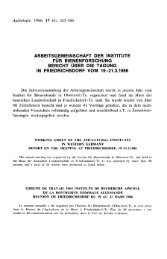

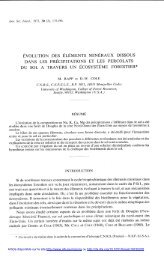
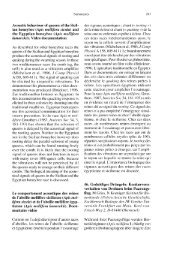
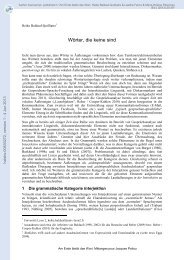
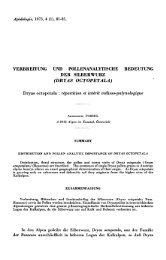
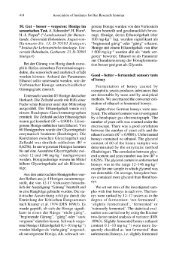
![4 C]-Polyethylenglykol bestimmt, der - HAL - INRIA](https://img.yumpu.com/22454280/1/177x260/4-c-polyethylenglykol-bestimmt-der-hal-inria.jpg?quality=85)
